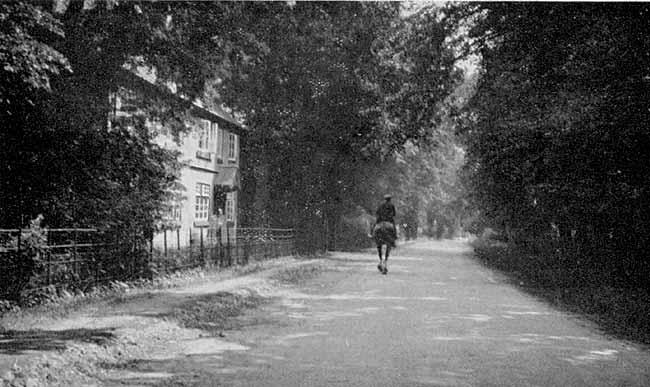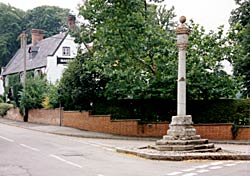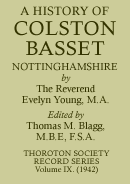< Previous | Contents | Next >
Chapter I.
Old traditions

Hall Lane, Colston Bassett.
LOCAL traditions are always interesting; however absurd they may appear in their present form, they are worth investigating, because, if the truth can be reached, it will be found that they rest upon some foundation of fact. But in the course of several centuries additions and alterations have been made to such an extent, that the original fact has been lost in a mass of fiction. This need not surprise us, if we only think how a little bit of gossip can be enlarged and distorted in a few days.
As regards the past history of time parish of Colston Bassett, there are two old traditions of interest that are still current among the villagers. These are closely connected with one another, one referring to the name of the place, the other to the exact site of the village. In fact we are asked to believe that to be two villages, Colston and Bassett, forming one parish; one of the two (I am not sure which) around the old church of St. Mary, and the other where the present village is— or elsewhere. But, though one of these has now disappeared, it is said that the two names survived, joined together as at the present day. In confirmation of this, it is pointed out that there was also a church in the present village, of which there are still some slight remains close to the bridge.
There is a good deal of truth in this; there is also something that is purely fanciful. As regards the present name of the place, Bassett is not a place name at all, but a family name; it was added to this Colston to distinguish it from the other Colston on the further side of Bingham, now known, as Car-Colston. The Bassetts were a powerful and wealthy Norman family, who possessed large estates in different parts of the country, including the manor of this Colston, which they held from the time of King Henry I. until the death of Ralph, the last Lord Bassett of Drayton, in 1390, that is to say, for a period of about 300 years. There is no doubt that they were always non-resident landlords; if they resided anywhere permanently, it would be at their chief possession of Drayton, in Staffordshire, now known as Drayton Bassett. In fact they were very much engaged in all the chief business and leading events of the country. For instance, the first Ralph Bassett held the important post of chief-justice of England, in which he was succeeded by his son Richard, the only head of the family who was not named Ralph; another was killed in the battle of Evesham in 1265; another was Steward of the Province of Aquitaine in France, then an English possession.

The old market cross was rebuilt in 1831 in honour of William IV's coronation. The Martin's Arms public house can be seen in the backgroumd (©A Nicholson, 2003).
The origin of the tradition about the two villages appears to be closely connected with the history of Kinoulton. When Domesday Book (which was really a land-register of the whole of England) was compiled about the year 1086, there was a considerable place known as Newbold in this there were, two separate manors, from which have grown the two separate parishes of Colston and Kinoulton, whereas the original Newbold has now disappeared altogether. The graveyard of the ancient parish-church of Kinoulton may still be seen high up on the wolds; the old chapel of Newbold was used as the parish-church until the present building was erected in 1780. There has always been a certain amount of overlapping between time two places. I have various references to people described as being “of Kinoulton in the parish of Colston Bassett,” the latest of these being 1680. It was shortly before this date that Dr. Thoroton wrote, “How the two townships parted this Newbold I cannot discover,” adding a remark about the vicar of Colston Bassett esteeming himself parson of Newbold. Even now part of the income of the benefice of Colston Bassett is derived from tithes paid on land in Kinoulton; and one piece of the vicar’s glebe known by the name of Gisburn is now in Kinoulton parish.
This, then may possibly account for the tradition about two villages. But the two would be either Colston and part of Kinoulton or Colston and Newbold. There is, however, another possible origin; for Thoroton, in the introduction to his history, mentions that he had omitted, by mischance and oversight, to insert many notes, including “some concerning Trewthales Mannor in Colston Bassett.” Here we have evidence of two distinct manors, if not of two separate villages. It is only my own suggestion that the river Smite divided the two manors, the Newbold manor to the West and Trewthales manor to the East of the river. The ancient (and I believe, unique) dovecote may certainly be looked on as a relic of this second manor; possibly also the enclosure known at one time by the name of “Oldehall Garde.”
In the year 1604 Colston Bassett suffered from a severe visitation of the plague. It is stated that “all communication was cut off by the inhabitants of the adjacent villages, between themselves and the wretched population of the infected town.” At the corner of the Owthorpe road there is said to be a “plague-stone” now covered with turf; on this were placed such necessaries as were supplied from outside, probably also the money disinfected in sonic way for the payment of these. In the registers are recorded the burials of 83 victims of the plague, the first being at the end of July and the last at the beginning of the following March most of the deaths occurred in August (20), September (26), and October (27). An old tradition says that one result of this visitation of the plague was the removal of the village, from the immediate neighbourhood of the old parish church, to its present situation. That there was originally a village clustered round the church is extremely probable, but in any case it had vanished, absolutely, before 1604. This gives us another instance of old tradition being at fault. Still, it is unlikely that there is no truth at all in it; it is certainly incorrect as regards the year 1604, but it may very well be true with reference to some former visitation. Such outbreaks were not infrequent, in different parts of the country, in days when sanitation (as we now understand the word) did not exist; some of these are recorded, doubtless there are many of which there is no record at all. The most terrible plague which the world ever witnessed was that known as the Black Death. This originated in Asia and spread over the whole of Europe. Of the three or four millions who then formed the population of England, more than one-half were swept away in its repeated visitations; the larger towns suffered the worst, but few, if any, villages escaped. This was in 1349; after all, a difference of two and a half centuries is not much when dealing with old traditions. Of course, there is no certainty in assigning the removing of the village to this period; it is merely thrown out as a possible suggestion.
